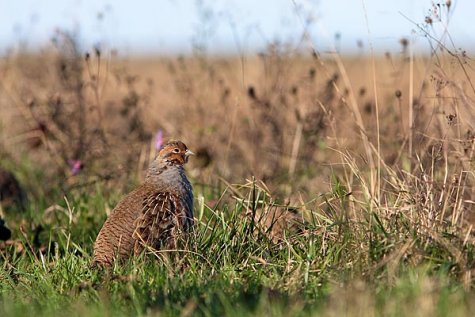Partridges flocking together
Photo: Kaarel Kaisel
Translation: Liis
Partridge
| Grey partridge or English partridge | Nurmkana | Perdix perdix |
The grey partridges or English partridges have been gathering in flocks as autumn advances. The birds, belonging to the hen or gallinaceous family, live mostly on the ground. They are skilled in running and hiding, and scratch in the soil like hens for food. If something alarming occurs they fly rather brief stretches, keeping near the ground – rise with a whirr, then a short glide and again a short flight: they don’t go far. The calls are also quite like those of hens. It happens, although very rarely, that they land to perch in trees.
When foraging they move with the neck stretched forwards, and the body seems to be hunched up ready for scratching in the ground. Food just now consists of weed seeds, green plants, their roots or tubers, found on agricultural lands and meadows as well as on the seashore. In cornfields there is plenty of fallen grain. They also search for hidden insects and invertebrates and gravel for grinding food in the crop.
Plumage is brown, the breast grey, tail is rust-coloured – a quite nice camouflage. The male bird has a brown patch on the belly, less clear in the female and the young birds. The beak is dark, the feet grey, and the weight around 400 grams – comparable to a very young hen in size.
They are sedentary birds so there will surely be cause to tell about the doings of the partridges in winter.









